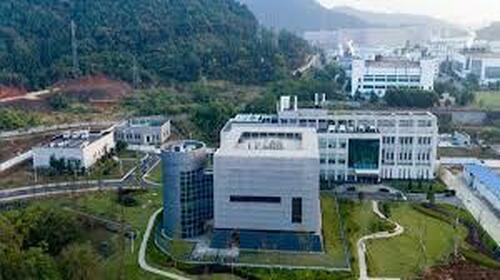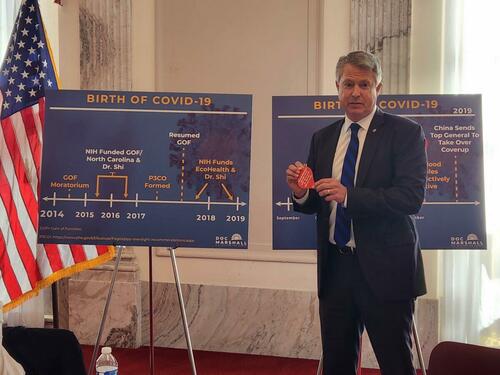
Authored by Zachary Steiber via The Epoch Times (emphasis ours),
The COVID-19 virus originated in a Chinese laboratory and was leaked unintentionally, a new U.S. Senate report concludes.
The virus, SARS-CoV-2, leaked from the Wuhan Institute of Virology (WIV), which tests bat coronaviruses, twice in 2019, researchers conducting the report say.
“The preponderance of information supports the plausibility of an unintentional research-related incident that likely resulted from failures of biosafety containment during SARS-CoV-2 vaccine-related research,” the 301-page report, released on April 17, states.
Sen. Roger Marshall (R-Ky.), a member of the Senate Health Committee, released the report, which was produced by a team that included Dr. Robert Kadlec, a longtime former government health official who played a key role in developing the COVID-19 vaccines, and staffers on the U.S. Senate Committee on Health, Education, Labor, and Pensions, where Marshall chairs the Subcommittee on Primary Health and Retirement Security. The final report updates an interim report released in the fall of 2022.
Researchers started with two hypotheses, Marshall told reporters in a briefing. One was that the virus started in animals before spilling over to humans, known as a natural origin. The other was a leak from the Wuhan lab, located in the same city where the first COVID-19 cases were detected in late 2019.
“They exhausted every piece of evidence that they could find, every resource witness that they could talk to, to come up with conclusions,” Marshall said.
Kadlec’s team of consultants spent approximately 18 months probing the COVID-19 origins and concluded that the available evidence supports a lab leak.
More specifically, there was likely an aerosol leak that caused an infection of lab personnel or the virus may have been released to the outside environment due to biocontainment failures. One theory revolves around cleaning agents causing corrosion of welded seams in the lab, a possibility mentioned in multiple 2019 documents on upgrading the lab.
“Patents addressed biocontainment faults with animal transfer cabinets, biosafety autoclaves, leaky airtight doors, and excessive corrosive disinfectants affecting stainless steel laboratory equipment and biocontainment structures,” the report states.

Both domestic and foreign bodies have for years raised concerns about biosafety at the WIV. A 2018 U.S. State Department cable, for instance, (pdf) reported that the then-newly opened biosafety level four lab at the facility had a “serious shortage” of trained technicians to safely operate the lab.
Researchers at the lab, before the pandemic, reported experimenting on mice, bats, and palm civets to find coronaviruses that were more capable of infecting humans, and sometimes experimented at sub-biosafety level four conditions. A more recent summary showed scientists conducted experiments that increased the function of a bat coronavirus. WIV’s refusal to reveal the full results of their experiments resulted in U.S. officials ending a subgrant after the pandemic started.
Research-related lab biosafety issues can unfold in a number of ways, while most infections acquired in laboratories due to lapses are never conclusively determined, researchers have said previously.
Chinese reports, communications, and notices were offered as support for the lab leak theory, including an attempt in November 2019 to procure an air incinerator at the lab. That suggested “some concern about the risk of an infectious aerosol escape,” researchers say in the new report. They also noted that WIV staffers underwent a remedial biosafety training course that same month.
Characteristics of SARS-CoV-2 suggest the virus was manmade, including the presence of a furin cleavage site at the same location that was proposed in a grant proposal by EcoHealth Alliance, the report concludes. EcoHealth funneled U.S. taxpayer money to scientists in Wuhan.
Read more here...
Authored by Zachary Steiber via The Epoch Times (emphasis ours),
The COVID-19 virus originated in a Chinese laboratory and was leaked unintentionally, a new U.S. Senate report concludes.
The virus, SARS-CoV-2, leaked from the Wuhan Institute of Virology (WIV), which tests bat coronaviruses, twice in 2019, researchers conducting the report say.
“The preponderance of information supports the plausibility of an unintentional research-related incident that likely resulted from failures of biosafety containment during SARS-CoV-2 vaccine-related research,” the 301-page report, released on April 17, states.
Sen. Roger Marshall (R-Ky.), a member of the Senate Health Committee, released the report, which was produced by a team that included Dr. Robert Kadlec, a longtime former government health official who played a key role in developing the COVID-19 vaccines, and staffers on the U.S. Senate Committee on Health, Education, Labor, and Pensions, where Marshall chairs the Subcommittee on Primary Health and Retirement Security. The final report updates an interim report released in the fall of 2022.
Researchers started with two hypotheses, Marshall told reporters in a briefing. One was that the virus started in animals before spilling over to humans, known as a natural origin. The other was a leak from the Wuhan lab, located in the same city where the first COVID-19 cases were detected in late 2019.
“They exhausted every piece of evidence that they could find, every resource witness that they could talk to, to come up with conclusions,” Marshall said.
Kadlec’s team of consultants spent approximately 18 months probing the COVID-19 origins and concluded that the available evidence supports a lab leak.
More specifically, there was likely an aerosol leak that caused an infection of lab personnel or the virus may have been released to the outside environment due to biocontainment failures. One theory revolves around cleaning agents causing corrosion of welded seams in the lab, a possibility mentioned in multiple 2019 documents on upgrading the lab.
“Patents addressed biocontainment faults with animal transfer cabinets, biosafety autoclaves, leaky airtight doors, and excessive corrosive disinfectants affecting stainless steel laboratory equipment and biocontainment structures,” the report states.

Both domestic and foreign bodies have for years raised concerns about biosafety at the WIV. A 2018 U.S. State Department cable, for instance, (pdf) reported that the then-newly opened biosafety level four lab at the facility had a “serious shortage” of trained technicians to safely operate the lab.
Researchers at the lab, before the pandemic, reported experimenting on mice, bats, and palm civets to find coronaviruses that were more capable of infecting humans, and sometimes experimented at sub-biosafety level four conditions. A more recent summary showed scientists conducted experiments that increased the function of a bat coronavirus. WIV’s refusal to reveal the full results of their experiments resulted in U.S. officials ending a subgrant after the pandemic started.
Research-related lab biosafety issues can unfold in a number of ways, while most infections acquired in laboratories due to lapses are never conclusively determined, researchers have said previously.
Chinese reports, communications, and notices were offered as support for the lab leak theory, including an attempt in November 2019 to procure an air incinerator at the lab. That suggested “some concern about the risk of an infectious aerosol escape,” researchers say in the new report. They also noted that WIV staffers underwent a remedial biosafety training course that same month.
Characteristics of SARS-CoV-2 suggest the virus was manmade, including the presence of a furin cleavage site at the same location that was proposed in a grant proposal by EcoHealth Alliance, the report concludes. EcoHealth funneled U.S. taxpayer money to scientists in Wuhan.
Read more here…
Loading…





